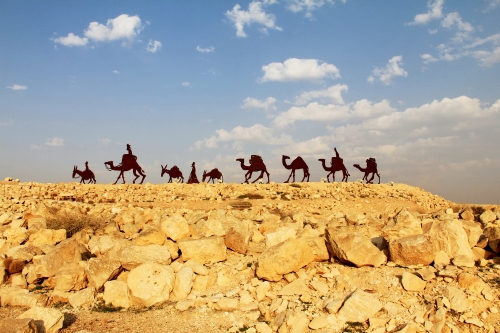Yesterday, we discovered the origins of the Silk Road.
From the Chinese coasts, across to the central steppes and over to Rome, the Silk Road left prosperity and wealth in its wake.
For the first time in human history, global trade made its mark.
Spices. Horses. Precious stones and metals.
And silk.
The Chinese cloth made waves with the Roman aristocracy. It was vogue and innovative…and the elite couldn’t get enough.
That led to blossoming trade and the formation of a well-developed Silk Road.
And it wasn’t just over land. The Roman occupation of Egypt opened maritime trade throughout the Red Sea, Arabian Sea and the Bay of Bengal.
The Byzantine Monks
During Byzantine Emperor Justinian’s rule around 550 AD, two Nestorian Christian monks uncovered the way silk was made.
For the roughly 600 years leading up to that point, most of China’s trade partners believed that silk came from trees.
600 years!
How they managed to keep that trade secret under wraps for so long is beyond me.
When these two monks figured it out, Justinian sent them as spies from Constantinople to China to steal silkworm eggs.
They stole the eggs and began making their own brand of silk in northern Greece.
At this point, all transcontinental trade went through Byzantine territory. The empire grew wealthy while acting as the middle man between the East and the Western Roman Empire.
The Silk Road still flourished, but the Byzantines held monopolistic influence over the goods that flowed through it.
On the Chinese end, the Tang dynasty helped guide the Silk Road to its golden era. Persian and Sogdian merchants benefited from the commerce along the land route. Arabs and Africans grew wealthy from the sea activity.
And it wasn’t only goods moving on the Silk Road. Scholars and representatives traversed the route to visit new lands.
They held noble titles and lived as esteemed diplomats.
It helped deepen trade relationships and establish the peace.
Khan and the Mongols
Fast-forward to the beginning of the 13th Century.
The Islamic world spread across much of the Chinese territory in the Middle East.
Caliphates had established firm control. They directed trade through the newly-built city of Baghdad.
The Islamic Turks’ dominance further weakened the Chinese influence. It also made the area prone to invasion.
About this time, the largest continental empire ever, the Mongol Empire, came to power.
It conquered and held key trade points along the Silk Road across the whole Asian continent. This helped unify the various geographical fragments under one political regime.
Thus, trade flourished.
Genghis Khan sent a diplomat named Rabban Bar Sauma to the courts of Europe in the late 13th century. He met with the English King, the French King, the Pope, and the Byzantine ruler at the time.
Bar Sauma observed European politics and economics. Then he reported back to Mongolia.
The Mongols adopted one effective practice. They began transplanting intellectuals from their conquered enemies to their own cities. This helped further the trade flows and economic growth along the route.
At the same time, Venetian explorer Marco Polo made his own journey along the Silk Road.
While he wasn’t the first European to walk those paths, he was one of the most illustrative.
His tales painted vivid pictures in the imagination of the West. He revealed regal courts, economic powerhouses and surprising sophistication.
But this mystical image would soon disappear… [openx slug=inpost]
The Black Death
One of the stops on the Silk Road was along Lake Issyk Kul in modern Kyrgyzstan. Around 1350 AD, villagers living around the lake started dying off in large numbers.
Scientists believe this was the outbreak of the Black Death.
A type of bacteria, Yersinia pestis, caused the disease. Rats carried it to fleas who then passed it on to humans.
The Silk Road hosted large populations of rats that thrived on the discarded rubbish.
The host rats could jump into the travelling caravans. They would then spread the bacteria to the goods and merchants.
It was like jumping on a superhighway that went straight from one mega-empire to another.
A perfect storm.
So, it’s not surprising that you can follow the outbreak along the Silk Road…from Kyrgyzstan to Afghanistan to Persia and all the way to the Black Sea.
It was at this point that the rats transferred from land to sea, jumping on ships headed to Western Europe.
That’s when the devastation began.
In two years the Black Death killed one-third of Europe’s population — about 34 million.
On the other end of the Silk Road, back in China, the disease killed two-thirds of the population — 25 million.
The death and destruction…combined with the disintegration of the Mongol Empire…left the Silk Road deserted.
All that remains…
After 1,400 years of prosperity, wars and conquest, the Silk Road met its demise.
Rats and fleas.
To be fair, that held true for most of the developed world at that time.
Over the next 600 years, trade between the East and the West sputtered in and out of fashion.
The Ottomans revived the land route for a time, but the Chinese never fully recovered.
The British East India Company formed in 1600 and rekindled the sea route. But the effects were more political than economic…
The power of the Silk Road was gone.
Until today.
Now, there’s a man who has the desire and capability to resurrect the Silk Road.
He’s putting the final touches in place…for a plan that has been centuries in the making.
A plan that could, if successful, return modern-day China to the fortune of the Han dynasty.
The man’s name is Xi Jinping and he calls the plan, the Belt and Road Initiative.
Like the ancient Silk Road, this initiative will span three continents and reach over half of the world’s population.
It’s how China plans to become the world’s next superpower.
More on that tomorrow.
Best,
Taylor Kee
Editor, Money Morning New Zealand
